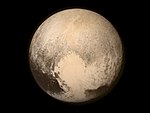
1620 Geographos is a highly elongated, stony asteroid, near-Earth object and potentially hazardous asteroid of the Apollo group, with a mean diameter of approximately 2.5 km (1.6 mi). It was discovered on 14 September 1951, by astronomers Albert George Wilson and Rudolph Minkowski at the Palomar Observatory in California, United States. The asteroid was named in honor of the National Geographic Society.

1036 Ganymed, provisional designation 1924 TD, is a stony asteroid on a highly eccentric orbit, classified as a near-Earth object of the Amor group. It was discovered by German astronomer Walter Baade at the Bergedorf Observatory in Hamburg on 23 October 1924, and named after Ganymede from Greek mythology. With a diameter of approximately 35 kilometers, Ganymed is the largest of all near-Earth objects but does not cross Earth's orbit. The S-type asteroid has a rotation period of 10.3 hours. In October 2024, it is predicted to approach Earth at a distance of 56,000,000 km; 35,000,000 mi (0.374097 AU).
4197 Morpheus, provisional designation 1982 TA, is a highly eccentric asteroid and near-Earth object of the Apollo group, approximately 3 kilometers in diameter. It was discovered on 11 October 1982, by American astronomers Eleanor Helin and Eugene Shoemaker at Palomar Observatory in California, United States. The asteroid was later named for Morpheus from Greek mythology.
4486 Mithra, is an eccentric asteroid and suspected contact-binary, classified as near-Earth object and potentially hazardous asteroid, approximately 2 kilometers in diameter. It belongs to the Apollo group of asteroids and is a relatively slow rotator.
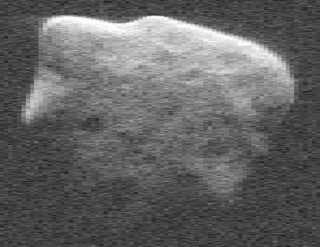
(53319) 1999 JM8 is an asteroid, slow rotator and tumbler, classified as a near-Earth object and potentially hazardous asteroid (PHA) of the Apollo group, approximately 7 kilometers (4 miles) in diameter, making it the largest PHA known to exist. It was discovered on 13 May 1999, by astronomers of the Lincoln Near-Earth Asteroid Research at the Lincoln Laboratory's Experimental Test Site near Socorro, New Mexico.
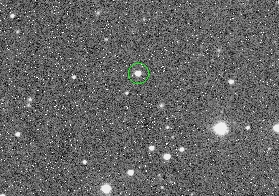
69230 Hermes is a sub-kilometer sized asteroid and binary system on an eccentric orbit, classified as a potentially hazardous asteroid and near-Earth object of the Apollo group, that passed Earth at approximately twice the distance of the Moon on 30 October 1937. The asteroid was named after Hermes from Greek mythology. It is noted for having been the last remaining named lost asteroid, rediscovered in 2003. The S-type asteroid has a rotation period of 13.9 hours. Its synchronous companion was discovered in 2003. The primary and secondary are similar in size; they measure approximately 810 meters (2,700 ft) and 540 meters (1,800 ft) in diameter, respectively.
(6178) 1986 DA is a metallic asteroid, classified as near-Earth object of the Amor group, approximately 3 kilometers in diameter. It was discovered on 16 February 1986, by Japanese astronomer Minoru Kizawa at Shizuoka Observatory, Japan.

3752 Camillo is an inclined contact-binary asteroid, classified as near-Earth object of the Apollo group, approximately 2.3 kilometers in diameter. It was discovered on 15 August 1985, by astronomers Eleanor Helin and Maria Barucci using a 0.9-metre (35 in) telescope at the CERGA Observatory in Caussols, France. Lightcurve studies by Petr Pravec in 1998 suggest that the assumed S-type asteroid has an elongated shape and a longer-than average rotation period of 38 hours.

(185851) 2000 DP107 is a sub-kilometer sized asteroid, classified as potentially hazardous asteroid and near-Earth object of the Apollo group that is notable because it provided evidence for binary asteroids in the near-Earth population. The PROCYON probe developed by JAXA and the University of Tokyo was intended to flyby this asteroid before its ion thruster failed and could not be restarted.
14827 Hypnos is a highly eccentric, sub-kilometer-sized carbonaceous asteroid that is thought to be an extinct comet. It is classified as near-Earth object and potentially hazardous asteroid of the Apollo group.
1916 Boreas, provisional designation 1953 RA, is an eccentric, stony asteroid and near-Earth object of the Amor group, approximately 3 kilometers in diameter. After its discovery in 1953, it became a lost asteroid until 1974. It was named after Boreas from Greek mythology.

3122 Florence is a stony trinary asteroid of the Amor group. It is classified as a near-Earth object and potentially hazardous asteroid. It measures approximately 5 kilometers in diameter. It orbits the Sun at a distance of 1.0–2.5 AU once every 2 years and 4 months ; the orbit has an eccentricity of 0.42 and an inclination of 22° with respect to the ecliptic. Florence has two moons.
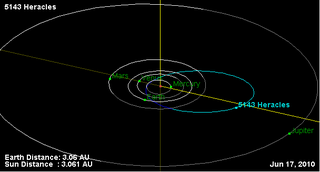
5143 Heracles is a highly eccentric, rare-type asteroid and synchronous binary system, classified as near-Earth object of the Apollo group, approximately 4.8 kilometers in diameter. The asteroid was discovered on 7 November 1991, by American astronomer Carolyn Shoemaker at Palomar Observatory in California, United States. It is named for the Greek divine hero Heracles. It has an Earth minimum orbit intersection distance of 0.058 AU (8.7 million km) and is associated with the Beta Taurids daytime meteor shower.
7088 Ishtar, provisional designation 1992 AA, is a synchronous binary asteroid and near-Earth object from the Amor group, approximately 1.3 kilometers in diameter. It was discovered on 1 January 1992, by American astronomer Carolyn Shoemaker at the Palomar Observatory in California. The relatively bright asteroid with an unknown spectral type has a rotation period of 2.7 hours. In December 2005, a 330-meter sized satellite was discovered, orbiting its primary every 20.65 hours.
3102 Krok, provisional designation 1981 QA, is a rare-type asteroid and slow rotator, classified as a near-Earth object of the Amor group, that measures approximately 1.5 kilometers in diameter.
12923 Zephyr (prov. designation:1999 GK4) is a stony asteroid, classified as potentially hazardous asteroid and near-Earth object of the Apollo group, approximately 2 kilometers (1.2 miles) in diameter. It was discovered on 11 April 1999, by astronomers of the Lowell Observatory Near-Earth Object Search at Anderson Mesa Station near Flagstaff, Arizona. The asteroid was named after the deity Zephyrus from Greek mythology.
(31345) 1998 PG is an eccentric, stony asteroid and binary system, classified as near-Earth object of the Amor group of asteroids, approximately 900 meters in diameter. It minor-planet moon, S/2001 (31345) 1, has an estimated diameter of 270 meters.

(66063) 1998 RO1 is a stony near-Earth object of the Aten group on a highly-eccentric orbit. The synchronous binary system measures approximately 800 meters (0.50 miles) in diameter. It was discovered by astronomers of the Lincoln Near-Earth Asteroid Research at the Lincoln Laboratory's Experimental Test Site near Socorro, New Mexico, on 14 September 1998.
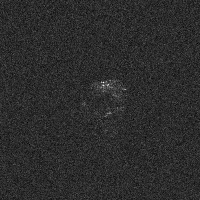
(436724) 2011 UW158, provisionally known as 2011 UW158, is a stony, walnut-shaped asteroid and fast rotator, classified as near-Earth object and potentially hazardous asteroid of the Apollo group, approximately 300 meters in diameter. It was discovered on 25 October 2011, by Pan-STARRS at Haleakala Observatory on the island of Maui, Hawaii, in the United States.

(164121) 2003 YT1, provisional designation 2003 YT1, is a bright asteroid and synchronous binary system on a highly eccentric orbit, classified as near-Earth object and potentially hazardous asteroid of the Apollo group, approximately 2 kilometers (1.2 miles) in diameter. It was discovered on 18 December 2003, by astronomers with the Catalina Sky Survey at the Catalina Station near Tucson, Arizona, in the United States. The V-type asteroid has a short rotation period of 2.3 hours. Its 210-meter sized minor-planet moon was discovered at Arecibo Observatory in May 2004.













